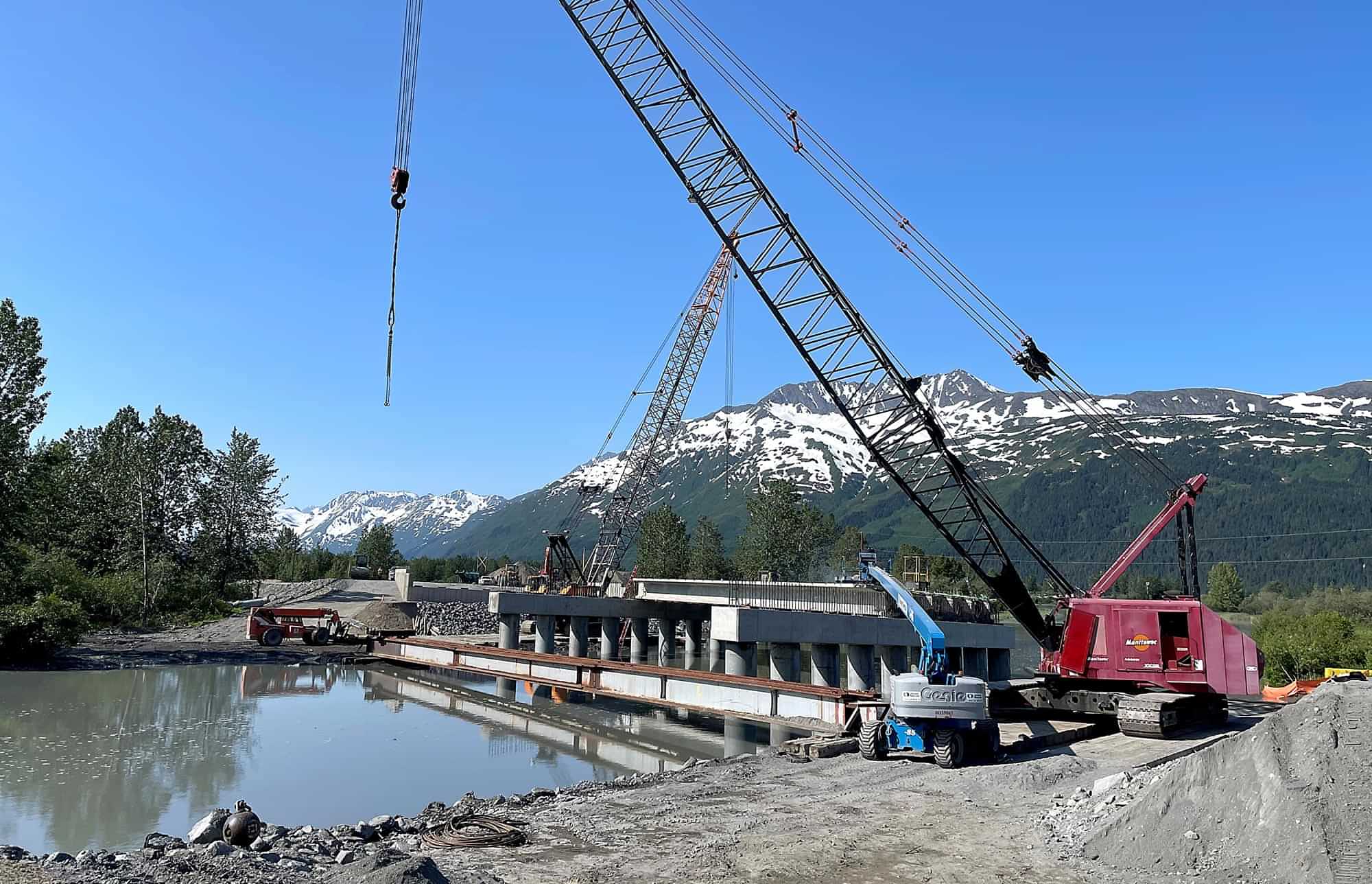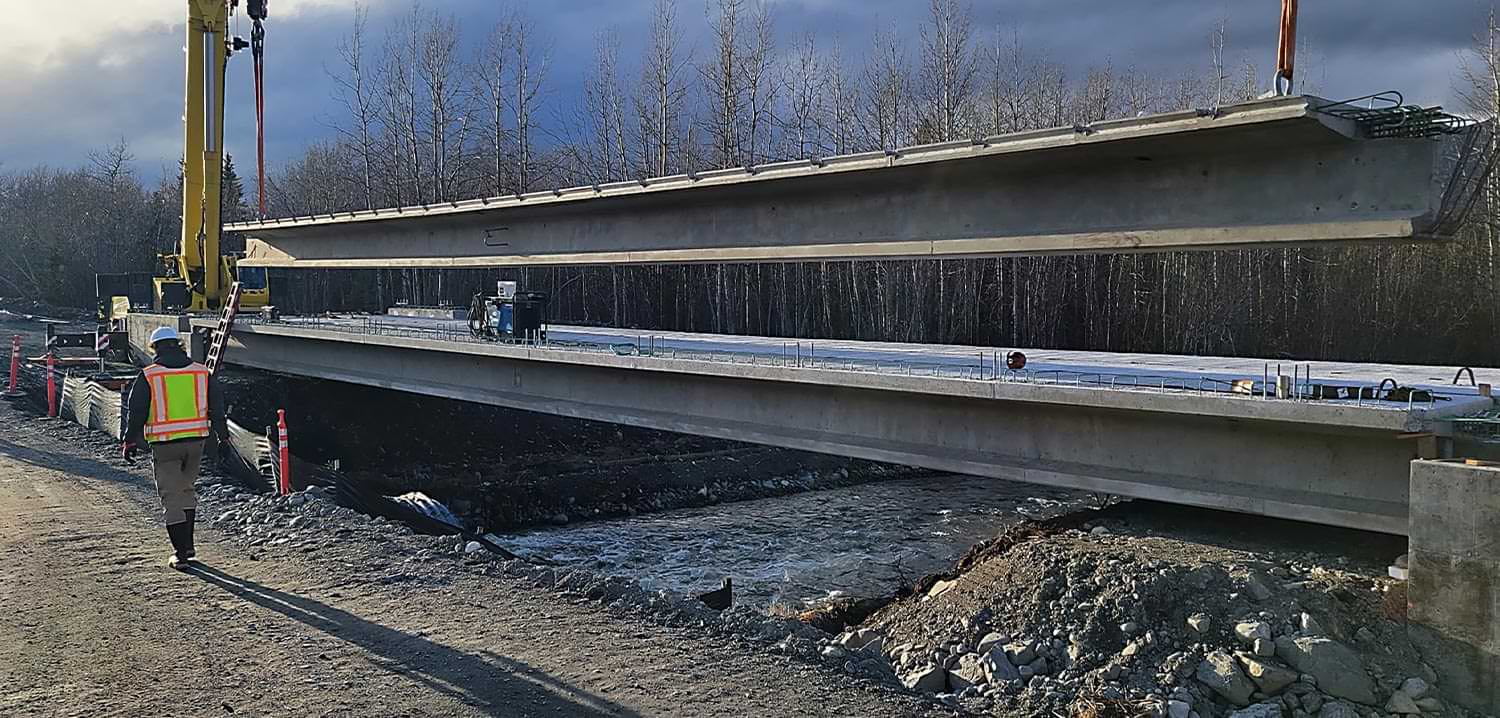Photo provided by Mass Excavation, Inc.

Bridge Rehabilitation Projects Improve Safety for Vehicles and Pedestrians

Photo provided by Mass Excavation, Inc.

Bridge Rehabilitation Projects Improve Safety for Vehicles and Pedestrians
onnecting Alaska’s communities by land requires a vast network of roadways regularly maintained for the safety of those who travel them. Managing the integrity of bridges that connect those roads takes careful planning among the entities that own them to prevent extended delays for both vehicle and pedestrian traffic.
Over the past year, several state-owned bridges have undergone renovation, rehabilitation, or replacement, with several projects slated for the coming year and others in the planning stages. Leslie Daugherty, chief bridge engineer with the Alaska Department of Transportation and Public Facilities, or DOT&PF, says bridge evaluation and repairs occur regularly and are scheduled according to funding, labor, and traffic logistics.

The Cushman Street Bridge Rehabilitation project in downtown Fairbanks includes seismic upgrades and improved pedestrian access in this major northbound roadway. Though increased pedestrian access reduced the vehicle lanes from three to two, Russ Johnson, highway design engineer and architect for the Alaska Department of Transportation and Public Facilities, says this design will make it safer for bridge users.
Graphic provided by The Alaska Department of Transportation & Public Facilities
A 2021 bridge inventory by the Federal Highway Administration identified 1,632 bridges in the state of Alaska, of which 134 bridges, or 8.2 percent, were noted as having key elements in “poor” or worse conditions. Only 9 of these bridges are on the highway system. The rest are on other key roads linking major airports, ports, rail, and truck terminals. Daugherty explains that of the 1,632 bridges, DOT&PF manages 1,055 bridges; maintenance for the remaining bridges is the responsibility of the Alaska Railroad, the military, federal, or tribal entities.
By federal law, DOT&PF must conduct routine bridge safety inspections every two years and rate them as “good,” “fair,” or “poor.” As bridges age and move towards the “poor condition” score, DOT&PF inspects them further to determine the amount of work necessary to return them to a “good” status. Several other factors determine if a bridge is renovated, rehabilitated, or replaced, such as if the bridge needs seismic updates, pedestrian access, or other improvements for an expected increase in use. DOT&PF also takes into consideration other project proposals in the area and decides if they can address several bridges within a single project. Daugherty says this is often possible due to Accelerated Bridge Construction, a process that involves building large portions of a bridge, such as girders and deck panels, offsite to reduce installation time.
Originally built in 1960, the Cushman Street Bridge began showing its age in the early ‘00s. In 2023, HC Contractors started a bridge rehabilitation project that included seismic upgrades, paved deck resurfacing, replacement of bridge railing to meet current crash standards, and the painting of steel girders. They also took the opportunity to widen the existing 5-foot sidewalks to 10 feet with a 6-foot shoulder and added illumination, landscaping, and Americans with Disabilities Act, or ADA, compliant upgrades that span into a new sidewalk path connecting Cushman Street to Gordon Wear Park.
Dave Arvey, DOT&PF construction manager, Northern Region, says supply chain issues delayed the project’s completion. Cushman is a one-way northbound route heavily used for commuters traveling from one side of town to the other. Generally, the crews maintained a single transit lane through the work but eventually shut down the bridge for a short duration during the resurfacing and sidewalk demolition.
“It’s hard to work on half the bridge as vehicles move through narrow barriers,” says Arvey. “It requires several lane swaps for motorists to adapt to throughout the construction sequence.”
Wider sidewalks and shoulder width meant decreasing the number of motorist lanes across Cushman Street Bridge from three to two.
“The bridge is a magnet for tourists and hosts multiple public summer events such as the Golden Days Rubber Duckie Race,” says Johnson. “This high-use pedestrian, tourist, and bicycle corridor had limited accommodations for non-motorized users. There has been an effort to improve pedestrian and bicycle safety for both motorists and non-motorists.”
The current construction estimate for this federally funded project is approximately $4.5 million. The project is expected to be completed in early 2023.

Photo provided by Mass Excavation, Inc.
Milepost 75 to 90 and Portage Curve Multimodal Connector
Cody Troseth, project manager for Mass Excavation, says age and seismic activity resulted in concrete decks that were bumpy and deteriorating. New pavement on the multiple t-section girders will allow traffic to flow smoothly over each bridge. The logistics for this project included temporary bridges to maintain traffic flow, timing parts of construction to avoid effects on wildlife and recreation activities like hunting and fishing, and working through winter to meet a tight schedule.
“Traffic is a big thing,” says Troseth. “We move truckloads of gravel at night to avoid disturbing traffic. We try our best not to affect activity in the area, and we are in close contact with the Wildlife Conservation Center to make sure they are aware of when we are driving piles this winter and spring.”
Troseth says the amount of gravel needed for this project is massive. To date, the company has moved more than 1.2 million tons of gravel to the work site, approximately three-quarters of what they will use to complete the project. This federally funded project is estimated to cost around $90 million. Crews plan to finish construction around October 31.


The new bridge that is part of the Little Tonsina Bridge Replacement project along Burma Pit Road is slightly north of the existing culverts, allowing for better fish passage, better flood mitigation, and a more natural stream. An analysis conducted by the Alaska Department of Fish and Game suggested that the two existing culverts were a barrier to fish passage and needed removal.
Photos provided by The Alaska Department of Transportation & Public Facilities
Quartz Creek Bridge
“The new bridge will provide easier access to the neighborhood in the area,” says John Sommer, owner of Tutka. “Right now, people have to wait at the end of the bridge for oncoming traffic to pass.”
The weight limit of the current bridge will create a slight challenge since Tutka will need to use a 180-ton crane to drive piles for the new bridge. Sommer says the crew will need to build a temporary bridge so the crane can work across the river safely.
Sommer anticipates a high number of tourists in the area during summer construction. Though Cooper Landing is quiet during the winter, it is a major recreational destination in the summer. He says flaggers will reroute traffic throughout the project to prevent disruptions. The Quartz Creek Bridge Replacement project is federally funded and estimated to cost around $8 million.
A hydrologic analysis of the site suggested that, prior to the Richardson Highway, the junction of the Little Tonsina with the main fork of the Tonsina River was 1.5 miles to the north. Highway construction most likely cut off approximately one mile of the river’s length, which straightened the river, causing erosion. The new bridge is slightly north of the existing culverts, allowing for better fish passage, better flood mitigation, and a more natural stream.
Sommer says the project faced a slight delay when a girder went missing. However, Tutka fast-tracked a replacement, and crews worked into the winter to finish the installation. This year, crews will complete bank stabilization and switch over traffic. Sommer expects Tutka to finish the project in the fall. Project costs are estimated at $2.9 million and are federally funded.